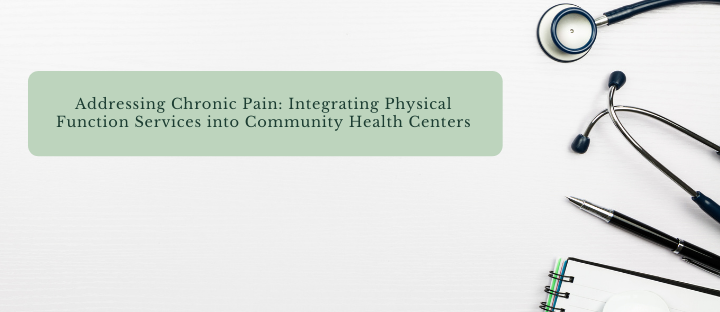Addressing Chronic Pain: Integrating Physical Function Services into Community Health Centers
By: Jevinne Khan, DC, Integrated Health Care Resident at Logan University
Chronic musculoskeletal (MSK) pain, which affects one in five people, is a national and local public health crisis. Chronic pain is associated with a significant socioeconomic burden due to its exorbitant healthcare-related costs and the high prevalence of pain-related disability.
This burden also contributes to the health disparities seen here in the United States. Chronic pain has been shown to disproportionately affect certain disenfranchised communities, such as those of low-income status, people who speak English as a second language, and many others. While treatment options for chronic pain are numerous and varied, these individuals often encounter barriers to receiving care. This disparity can be attributed to social determinants such as, but not limited to, lack of access to care, health insurance coverage, and reliable transportation.
Since its inception, the St. Louis Regional Health Commission (RHC) has been a driving force for providing access to care for the safety-net population. With their Gateway to Better Health Program, they have increased access by providing health coverage for primary care and specialty care in St. Louis City and County. Recently, as a result of their Chronic Pain Initiative, they introduced the Physical Function Improvement Benefit which provides access to physical function services such as chiropractic, occupational therapy, and physical therapy.
Providing access to these non-pharmacological treatments was only part of the solution in addressing chronic pain. The RHC worked with various stakeholders such as CHC leadership, educational institutions, and multidisciplinary providers, to integrate physical function services into the primary care home model. This integrated model provides increased access to evidence based non-pharmacological pain management, decreases the burden on primary care providers, and promotes health equity in chronic pain.
Bernadette Sheffield, MSOT, OTR/L, an occupational therapist who works within several community health centers in St. Louis, said the following about the integration model:
“Most of the clients I see are uninsured or underinsured. Through this partnership, clients have had greater access to necessary therapy services to facilitate patient function, independence, and care, and to promote independent health maintenance and management. Thank you, Regional Health Commission for your continued advocacy for those in need.”
Bernadette Sheffield , MSOT, OTR/L,
These integration efforts have been outlined in a recent white paper titled Addressing Chronic Pain: Integrating Physical Function Services into Community Health Centers. The paper details the process undertaken by the RHC to implement chiropractic, occupational, and physical therapy services on-site. The RHC hopes that their efforts serve as an example of integrated multidisciplinary care for CHCs beyond the St. Louis Region.
“This progressive initiative has greatly reduced health inequities in our region, providing access to safe, effective, evidence-based care for the treatment of chronic pain, stated Patrick Battaglia, DC, DACBR, who oversees the clinical integration efforts at several regional community health centers. “As a practitioner within this benefit, it has been rewarding to see patients improve their well-being, living with less pain and engaging more in valued daily activities. This program should serve as a model nationally for how to integrate non-pharmacologic therapies for pain management and functional restoration within the primary medical home.”
Patrick Battaglia, DC, DACBR

